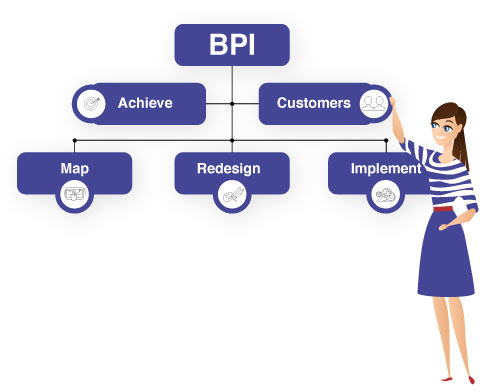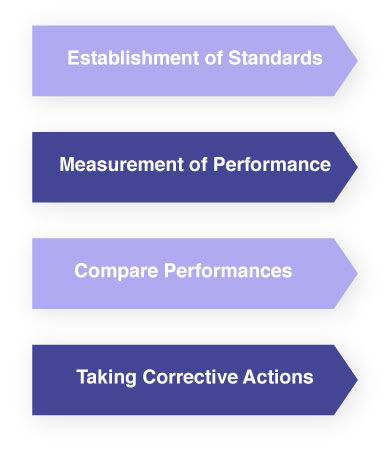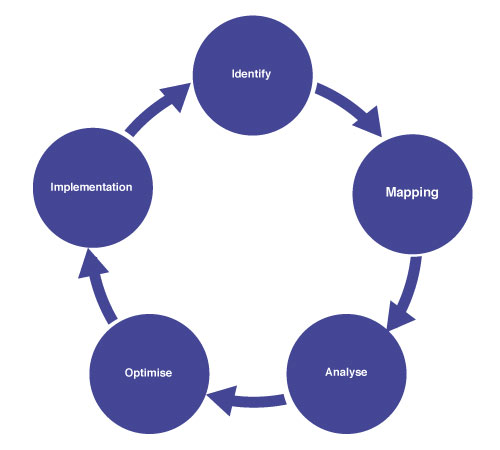What is Business Process Improvement
In any organization, there are bound to be problems related to the project. These problems might differ from one organization to another. To counter these problems, an organization uses a tool called Business Process Improvement (BPI). In the past, it has proven to increase the efficiency of the working process.
Every organization has a business process that it follows to get desirable outputs. The effectiveness of these processes influences the growth of your business.
In this blog, we will talk about Business Process Improvement in detail. We will also explore how this method helps all organizations.
What is Business Process Improvement?

Every organization has a set of departments, and each performs specific tasks to produce results. But due to various reasons, the performance of the team gets overlooked. This negatively impacts the growth of your business and its performance.
This is where Business Process Improvement helps you. This is basically a process that has certain practices to keep the performance in check. This, in turn, increases the efficiency of your business process.
Business process improvement involves various processes like discovering, mapping, documenting, analyzing, and redesigning. Simply put, business process improvement is evaluating the current process and altering them if needed.
Factors that indicate an ineffective business process
The following is a compilation of all the factors that show your business process is failing. If you have any of the problems listed below, you are in dire need of Business Process Improvement (BPI).
1. Lack of standardized activities:

When there are no standardized activities, you must figure out processes from scratch. This results in the non-repeatability of the process. This increases the time taken to complete repeatable tasks. When you are in this situation, your organization needs to start practicing BPI.
2. Lack of clarity in information:

One major cause of inefficiency is that the employees do not fully understand the process. This results in faulty execution of the process. This area needs fixing. It would help if you educated your employees about the correct way of execution. A business process improvement does this by looking for places where efficiency lacks.
3. Lack of control over the processes:

Every process faces various kinds of hurdles on its way to completion. At those times, it is essential to have control over your project. There are some main elements that you must have control over. They are process standards, accountability, documents, and responsibility. If you lack control over these processes, it is a key indicator that your organization must use business process improvement.
4. Erratic output:
The main goal of following a business process is to produce good results constantly. If your outcome is inconsistent for the same process, there are gaps in your process that need attention. You MUST start working on implementing BPI if your organization produces inconsistent results.
5. Unsatisfied customers:
Your organization must have worked hard to gain customers. But it all comes down to the efficiency of your process to retain customers. If your customers aren’t satisfied, retainment rates go down. This is a clear sign that you have to improve your process or entirely change your business process.
6. No time for life
Believe it or not, a proper business process will let you have a proper life experience. It will consider employees’ workloads and try to decrease them. If your business process makes you miss out on life experiences, it is not an efficient plan. A proper business process improvement in place helps you look for inefficiencies that lead to overworking employees.
Now that we have looked at the various indicators, we will look at the Business Process Improvement cycle.
Business Process Improvement Cycle

There are some standardized methods like Six Sigma and more to improve the business process. But whatever the method be, it always contains the following basic steps:
1. Identify
An organization employs business process improvement for various reasons. The following are some of the most common reasons:
- Cost reduction
- Optimisation
- Improving performance
Before starting the BPI implementation, identify what you need the business process improvement for.
2. Mapping
Business process improvement is essentially like a project. You must execute it in the same way as a project. The mapping step in BPI is similar to the planning step in project management. This step involves the identification of components and subcomponents of the selected process. Then you must put those activities in the order of execution. The final step is to connect all the laid-out activities, creating a flowchart/map of the process.
3. Analyse
This step is one of the most important steps as it points out any mistakes in the mapping process. One of the effective ways to ease the analyses is to ask yourself questions about the selected steps. For example, ask yourself if a step is really necessary for the process. This kind of question paves the way to make the process more efficient.
4. Optimise
After completing the analysis, you would have an idea about what you can make improvements to. Thus, this step focuses on making changes to the business process improvement steps. When you make changes to the strategy, you must be clear about making it realistic.
5. Implementation
This is the final step of the BPI. After careful evaluation, it is time for you to implement the improvements identified. The cycle of BPI doesn’t stop here. There will always be room for improvement when it comes to business. And BPI redesign is one of the effective ways to do it strategically.
The above steps improve the overall quality of the business process improvement. Make sure your BPI attains the desired goal by testing it out regularly.
Benefits of implementing Business Process Improvement
The main goal of Business Process Improvement is to make your business process more efficient. But it accomplishes more than that. The following are the key benefits of using Business Process Improvement:
1. Minimise costs:
Business process improvement focuses on eliminating long processes. This benefits the organization by reducing the cost spent on prolonged hours. For reducing costs without compromising productivity, BPI is the best way to go.
2. Maximise productivity:
Business process improvement identifies redundant processes in your business and removes them. It also replaces them with better processes that increase productivity. So it naturally has a direct and positive impact on productivity.
3. Keeps your employees happy

Keeping your employees happy might not be your topmost priority, but it should be. A satisfied employee gives more input to the organization than an unsatisfied one. Business process improvement reduces overloads. Thus, it proves beneficial to the employee’s mental health.
4. Boosts customer satisfaction

Business process improvement focuses on improving the workflow. Better workflow leads to better results. Thus an organization provides customers with valuable products every time. This improves customer satisfaction and improves customer retainment rates.
Conclusion
The successful implementation of Business Process Improvement makes your business sore in a short span of time. The best way to maintain the productivity of your organization is to stay updated with times. Technology is constantly evolving, and so are the business methods. Moreover, never stick to the same process, just because it is well documented.
Try out some well-tested methods like integrating automation in all sectors of your organization. After reading this blog, you must have understood the importance of using a BPI. You also know by now that BPI is very much like a project. The success of both depends on the proper execution of the laid-out plan. Reach out to PeppyBiz, by scheduling a free demo to learn more about our services.


